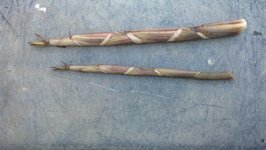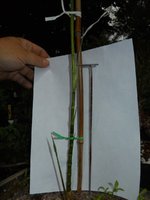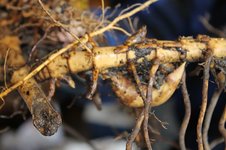The tray was planted in March, the first of the rhizomes peaked above the mix around May 19
New culms are soft, like tender asparagus, great for eating, or stir fry. They are sheathed in layers of culm sheaths, these provide the rigidity needed until the internodes expand and lignify enough to be self supporting. The culm sheaths also provide protection from moisture loss. By removing these culm sheaths, the lengthening of the internodes is retarded by the removal of the culm sheaths. Photos of 2 culms that I was harvesting to eat. One split to show the individual septum at each node.


Because the bamboo shoot expands very rapidly, an inch or two per day, you must daily remove each additional culm sheath. By timing when you remove the sheath, you can control the length of the internode. Just as with trees, the lowest internodes should be longer, the upper internodes should be shorter.


On June 1, 2014 removed the lowest culm sheaths. the tender culm proved to be "floppy", so I staked it up. Note: If you attempt to do this, have stakes or other supports long enough to support the entire "future" length of the culm. In the course of 14 days I had to tape together stakes to make a support long enough to support the culm in a straight position. If the culm is not held perfectly straight, when the culm lignifies, it will harden into a crooked position. (another one of my mistakes).


June 4, more sheaths removed


June 7, more sheaths removed, and had to cobble together more supports for the height.

June 11 lower part has hardened somewhat. This culm would have been about 40 inches tall if left to grow without peeling. I neglected to write down the exact measurement, but the shortened internodes resulted in a much shorter culm,

Then shortly after the last photo, we had a windy day, the culm broke off, in part because of my awkward cobbled together support. That culm died. Then during the summer, while I was out of town on a long weekend, the tray dried out and the whole planting died. I have not attempted again. I really should. It is a time consuming project, and in spring I am busy on the family owned blueberry farm.


 figure from Naka after
figure from Naka after 















